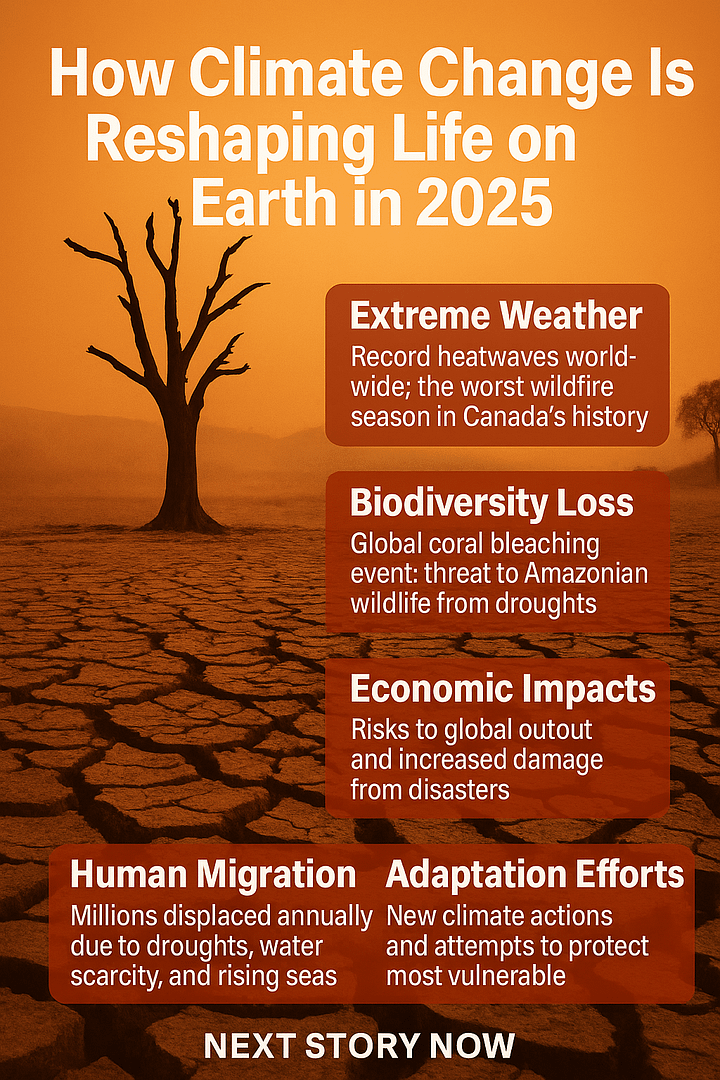Introduction
In 2025, the reality of climate change is more palpable than ever. From unprecedented heatwaves to shifting ecosystems, the planet is undergoing transformations that affect every facet of life. This article delves into the current state of climate change, its multifaceted impacts, and the global efforts underway to address this pressing issue.
1. Escalating Extreme Weather Events
The frequency and intensity of extreme weather events have surged. Europe and Asia have experienced record-breaking heatwaves, with temperatures soaring above 45°C. Canada faced its worst wildfire season in history, burning over 10 million hectares. These events not only disrupt daily life but also strain emergency services and infrastructure.
2. Biodiversity Under Threat
Coral Reefs in Crisis
The ongoing global coral bleaching event, starting in 2023, has affected approximately 84% of the world’s coral reef ecosystems. Elevated ocean temperatures have disrupted the symbiotic relationship between coral and algae, leading to widespread bleaching and mortality. This loss threatens marine biodiversity and the livelihoods of communities dependent on reef ecosystems.
Amazonian Wildlife at Risk
In Brazil’s Caxiuana National Forest, conservationists are working to rehabilitate endangered species like the Amazonian manatee. Climate change-induced droughts and rising water temperatures pose significant threats to these efforts, highlighting the broader challenges faced by conservation initiatives in a warming world.
3. Water Cycle Disruptions
Climate change has severely destabilized the global water cycle. The World Meteorological Organization reported that 2023 saw the driest year for rivers in at least three decades. Major river basins like the Mississippi, Amazon, Ganges, Brahmaputra, and Mekong experienced significant drying. Additionally, glaciers lost over 600 gigatons of water, marking the largest water loss in the last 50 years.
4. Economic Implications
By 2025, it’s projected that 31% of global economic output will face high or extreme climate change risks. Emerging markets, particularly in Asia, are especially vulnerable due to their rapid growth and limited adaptive capacities. For instance, India’s experience with Cyclone Phailin resulted in over $4 billion in damages, underscoring the economic vulnerabilities to climate-induced disasters.
5. Health and Human Well-being
Heat-Related Health Risks
The increasing frequency of heatwaves has led to a surge in heat-related illnesses and deaths. In 2023, Europe alone reported over 61,000 heat-related deaths. Vulnerable populations, including the elderly and children, are at heightened risk.
Maternal and Child Health
Global research initiatives are exploring the impact of climate change on maternal and child health. Rising temperatures are linked to adverse pregnancy outcomes, including preterm births and low birth weights. Understanding these connections is crucial for developing targeted public health interventions.
6. Climate-Induced Migration
The escalating impacts of climate change are rendering significant portions of the world uninhabitable, displacing millions annually. Droughts, water scarcity, and rising sea levels are primary drivers of this displacement. The UNHCR reports that approximately 32 million people were displaced in 2022 due to weather-related hazards, with numbers steadily increasing. Projections suggest that by 2050, climate refugees could number up to 1.2 billion.
7. Policy and Governance Challenges
Climate policy has become a contentious issue in global governance. The Trump administration’s efforts to dismantle the Federal Emergency Management Agency (FEMA) and shift disaster response responsibilities to individual states have raised concerns about the nation’s readiness to handle climate-induced disasters. Critics argue that such decentralization could exacerbate existing issues and reduce the nation’s preparedness.
Additionally, the Department of Justice has filed lawsuits against states like Hawaii, Michigan, New York, and Vermont over their climate actions, asserting conflicts with federal authority. These legal battles highlight the complexities of climate governance in the United States.
8. International Legal Developments
The International Court of Justice (ICJ) is expected to issue an advisory opinion on the obligations of states to address climate damages. Initiated by Vanuatu and supported by over 130 countries, this opinion could establish a global benchmark for climate accountability, reinforcing the connection between human rights, sustainability, and environmental protection.
9. Adaptation and Mitigation Efforts
Countries are taking varied approaches to address climate change. Azerbaijan, host of COP29, announced plans to submit its delayed national climate action plan by September 2025. The country aims to generate 30% of its electricity from renewable sources by 2030 and expand its solar and offshore wind capacities.
In the UK, unseasonably warm spring weather led to an early glut of fruits and vegetables, closing the traditional “hungry gap.” While this presents opportunities for adaptation, it also underscores the increasing volatility brought about by climate change.
Conclusion
The year 2025 stands as a testament to the profound and far-reaching impacts of climate change. From ecosystems and economies to human health and governance, no aspect of life remains untouched. Addressing this multifaceted crisis requires coordinated global action, innovative solutions, and a steadfast commitment to sustainability. As the challenges mount, so too does the imperative for decisive and collective action.

